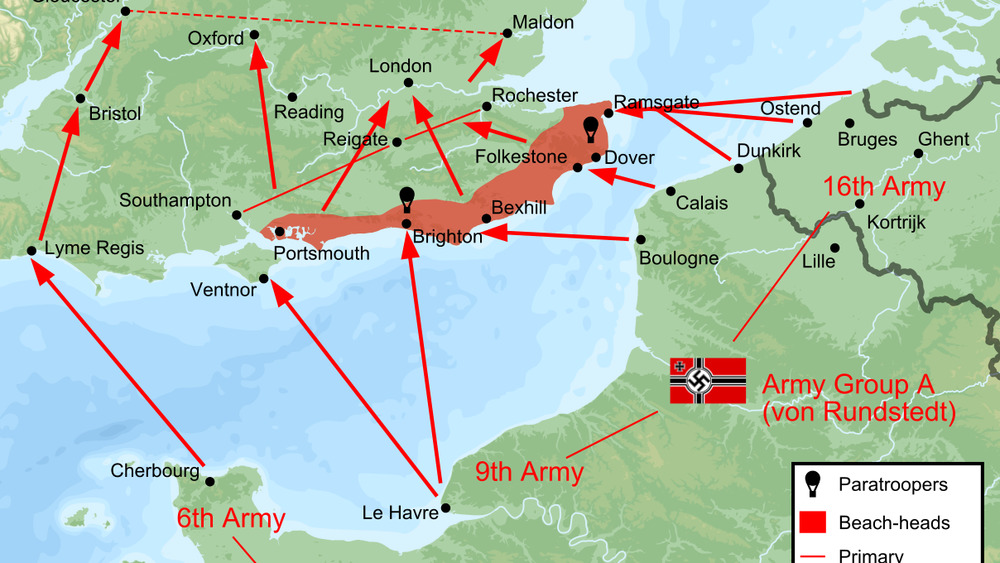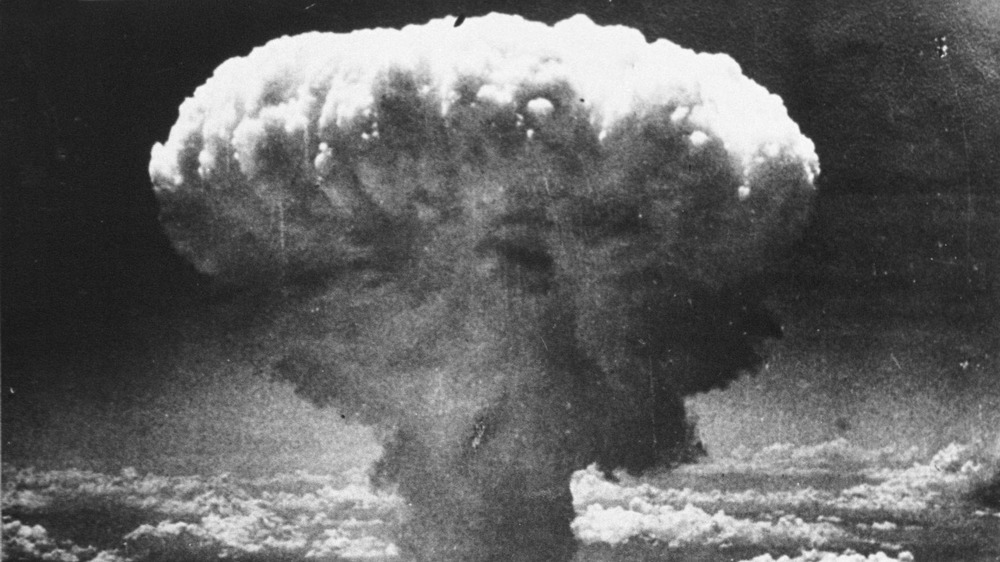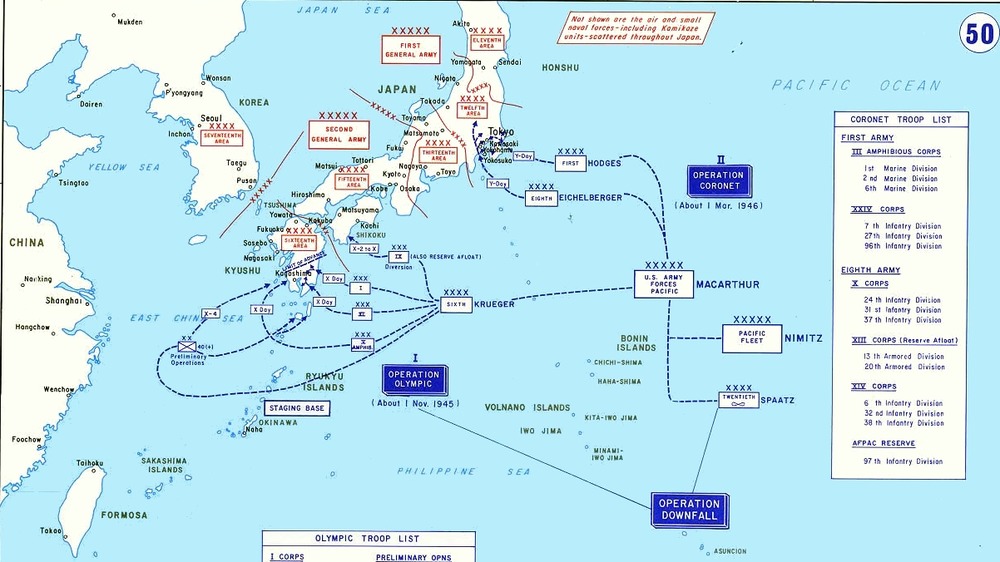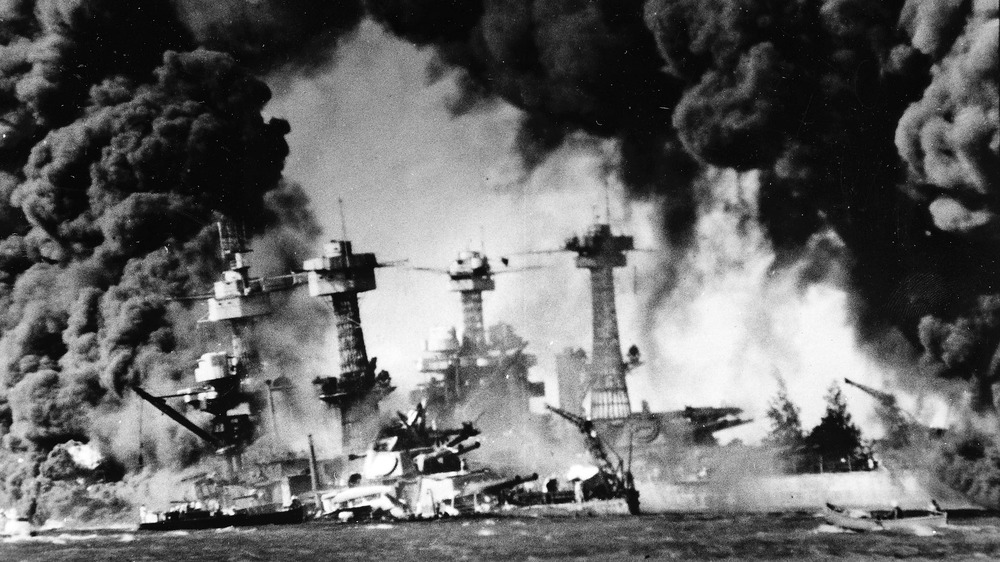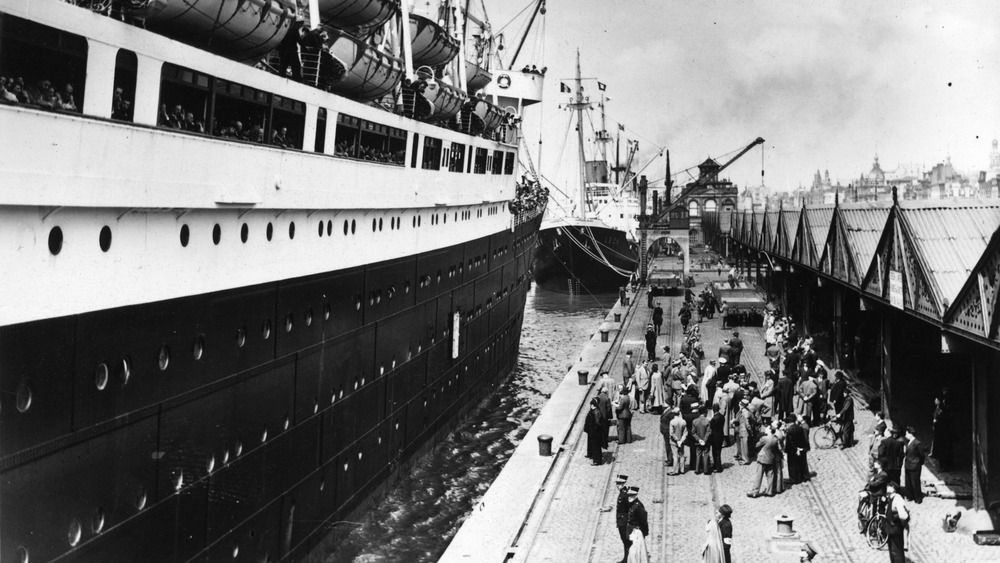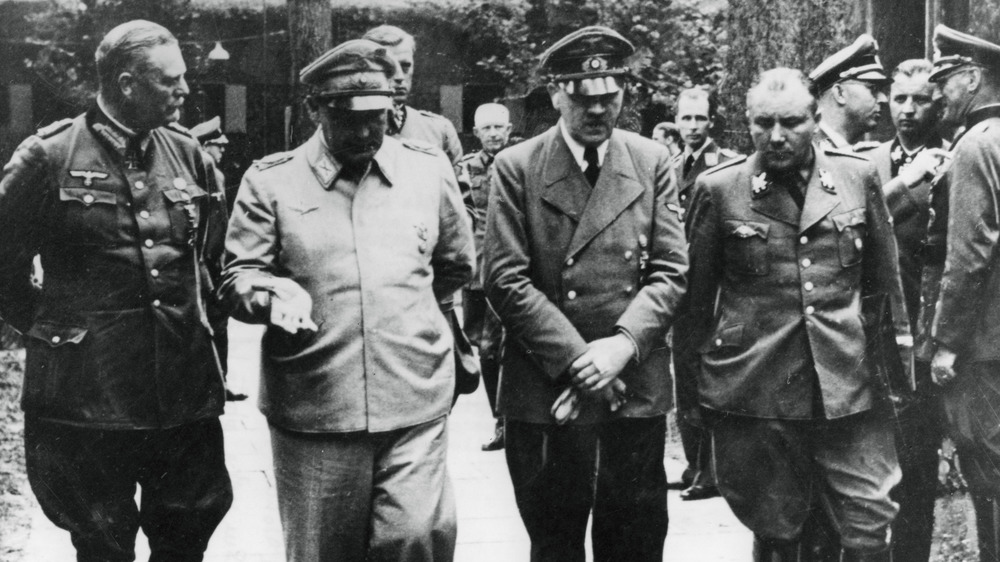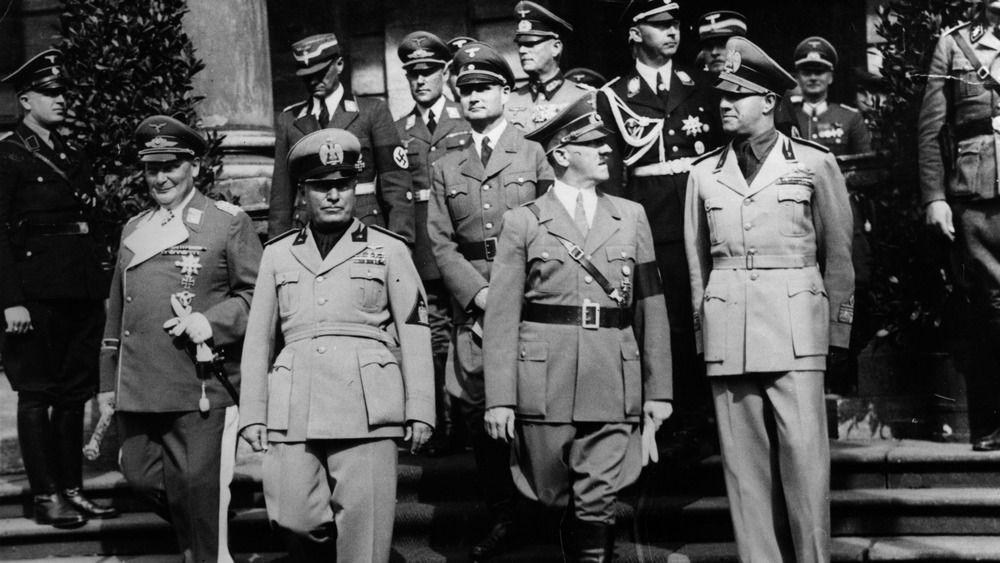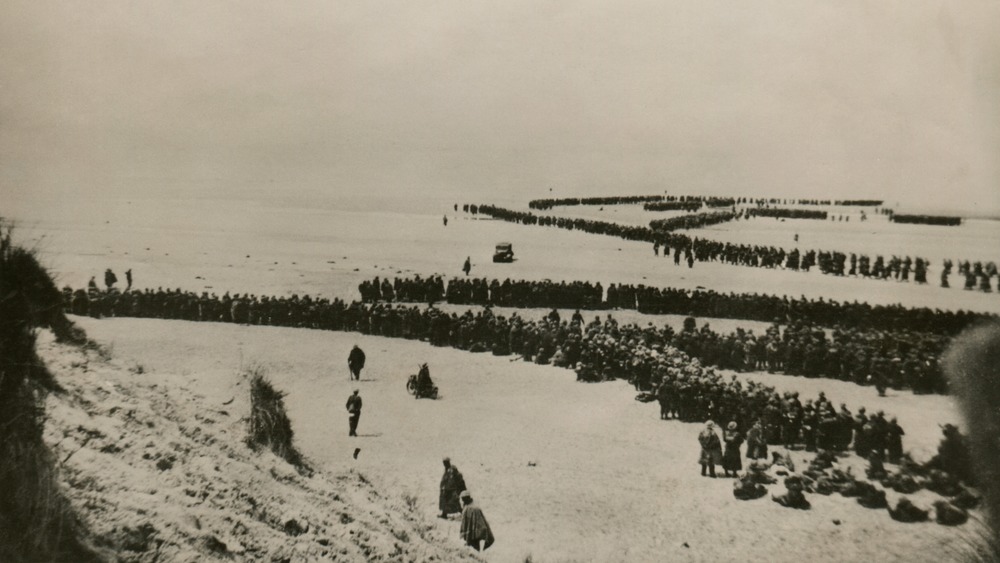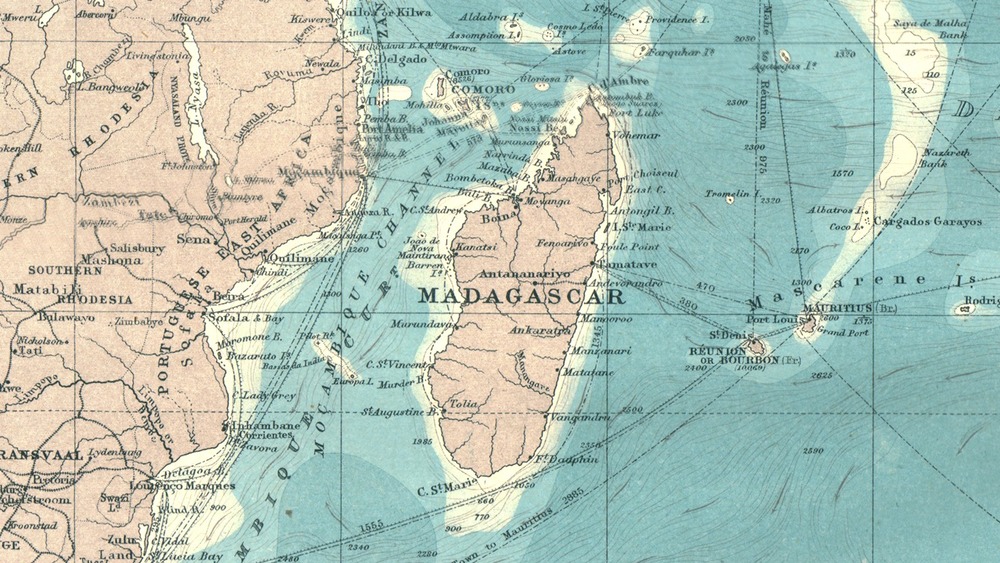Ways People Think WWII Could Have Ended Differently With One Small Change
The question of whether or not things could have been different is one that follows most historical events. Innumerable alternate histories have been written about World War II, and many of them confront the question of how much of an effect a small or a big change could have had.
Sometimes, history is made by a single wrong turn. Other times, the web of connections is so intricate that snapping half of them just doesn't have much of an effect. Some events, once scrutinized, are found to have way more variables involved influencing the course of history. Other moments turn into massive "what ifs" that could have happened but simply ended up not happening. But despite the many "what ifs" of World War II, it turns out that much of the war isn't as variable as people think. And although alternate histories often deal with events that are already considered significant, they can also confer significance onto events.
Ultimately, the only way that history could have happened is the way it did happen, because the present is what we're left with. But looking back at history, looking at how we call it history, and how we identify causes and effects is one of the best ways to understand that the past is not synonymous with history. And only by understanding the intricacy of the past can one realize the possibility of the present. These are some ways people think World War II could have ended differently with one small change.
Could Germany ever have invaded Britain?
An invasion by the Germans held off only by the brave British forces in the sky has long held fast in peoples' imaginations. After Winston Churchill rejected Hitler's peace settlement in 1940, Germany began planning for Operation Seelöwe, or Sealion, an invasion of Britain across the English Channel.
Historians have often coupled the abandonment of Operation Sealion with Germany's defeat during the Battle of Britain. While victory for the Luftwaffe would've made Britain vulnerable to invasion, by winning the Battle of Britain, it's claimed that the Royal Air Force (RAF) destroyed any chance of Operation Sealion's success, which is why Germany never attempted to go through with Operation Sealion.
But according to Invasion, 1940, by Derek Robinson, the Battle of Britain didn't actually have much to do with the abandonment of Operation Sealion. Not only were the German armed forces uncoordinated, but the Allied invasion of France took years to plan and was developed through smaller invasions. Plus, the German army had less than ten destroyers, while the Royal Navy's craft numbered over 60.
Ultimately, if the plan had been undertaken, there's little-to-no chance that it actually would have succeeded. And despite the threat of paratroopers, the "boogeymen of the invasion forces," Robinson points out that the German parachutes couldn't be steered, and their weapons were sent in a separate container, which had to be subsequently located after landing. Even if Germany had tried, an invasion of Great Britain was never likely to happen.
Germany was never close to making an atomic bomb
The race to build the atomic bomb was never really much of a race to begin with, because one side wasn't really participating. Although the Germans had a nuclear weapons program during the war, few resources were devoted to the project.
According to PBS, while German scientists knew they could make an atomic bomb in principle, they also realized that it would take an enormous devotion of resources. When asked by German Army Ordnance in 1941-1942 when nuclear weapons could be expected, German scientists admitted that the weapons couldn't be realized any time soon. In response, the Army Ordnance decided that although laboratory research could continue, an industrial-scale project wasn't going to be done. Instead, the Germans poured their resources into building jet planes, rockets, and other forms of military technology.
According to Spiegel, while there have been some claims that Germany conducted several nuclear weapons tests in the last two years of the war, the claims lack credibility, and soil sample readings show "no indication of the explosion of an atomic bomb" at the supposed detonation sites.
In the end, there was little chance that Germany was going to develop an atomic bomb at the same rate or before the United States. The U.S. ended up pouring $2 billion into the Manhattan Project, an amount equivalent to over $20 billion today. Germany decided to spend their resources elsewhere and lost a game they didn't realize they should've been playing.
Dropping the plague on San Diego
One plan of World War II that was dangerously close to being executed was Operation PX, by the imperial Japanese government, also known as Operation Cherry Blossoms At Night. The plan entailed dropping cargo over Southern California that was filled with plague-infected fleas. Once the fleas infected the rats, the rats would infect the food supplies, which would in turn spread the infection to the people.
This plan wasn't a diabolical daydream. The imperial Japanese government had already experimented with dropping plague-infected fleas at Ningbo and Changde and seeing its success, they wanted to expand their efforts. But according to The Japan Times, the only reason that the plan wasn't carried out was because of the United States' bombing of Hiroshima and Nagasaki. With Japan's surrender on Aug. 14, 1945, the plan was abandoned merely five weeks before its execution date.
It's likely that even if the plague hadn't proliferated through the U.S., it would've caused a lot of damage. Between 1900 and 1966, the mortality rate for the plague in the U.S. was 64%.
Although Germany had surrendered already in May 1945 and the fighting in the Pacific seemed to be winding to a close, it's possible that if the war had dragged on through the end of the year, then Southern California would have found itself dealing with the plague, and it's questionable how well the U.S. would have dealt with it.
How likely was an invasion of Japan?
Before the decision was made to drop the nuclear bombs, the Allied forces also toyed with the idea of invading the Japanese home islands. Known as Operation Downfall, the plan consisted of two main operations. According to PBS, the first phase was known as Operation Olympic and involved an invasion of Kyushu. Operation Olympic was meant to involve only troops who were already in the Pacific and was scheduled for Nov. 1, 1945. If Kyushu was successfully captured, that would allow for the second phase, Operation Coronet. Scheduled for March 1, 1946, the plan involved an invasion of Honshu and the Tokyo plain.
According to Military History Now, if executed, Operation Downfall would've been the deadliest campaign of World War II. It's estimated that the death count would have been as much as 10 million, counting both civilian and military. In comparison, the total body count for World War II ended up being about 50 million.
President Harry S. Truman had already signed off on Operation Downfall, and those involved were aware of the potential death toll. The United States military even produced half-a-million Purple Hearts in anticipation of the heavy casualties. And since the invasion never happened, the medals were put into storage, and the military has been pulling from the stockpile ever since. There's roughly still 100,000 left as of 2012.
Ultimately, the atomic bomb was developed first instead. But if it hadn't been, an invasion was queued up.
Was Pearl Harbor provoked?
The attack on Pearl Harbor by the imperial Japanese army is considered to be the attack that directly resulted in the United States joining World War II. But some historians question how much President Franklin D. Roosevelt and the U.S. were actually goading Japan into attacking Pearl Harbor.
One argument is based around the idea that because the American public was so opposed to being directly involved in another war, Roosevelt knew that he had to draw the Japanese into attacking the U.S. first. According to Independent Institute, the Roosevelt administration repeatedly dismissed Japanese attempts to have a harmonious relationship and imposed a series of sanctions. By 1940, Roosevelt had also put an embargo on "scrap iron and steel to destinations other than Britain and the nations of the Western Hemisphere." By 1941, Japanese assets in the U.S. were frozen. It's also claimed that American cryptographers had broken the Japanese code and knew that the Pearl Harbor attacks were going to happen. So in an attempt to motivate the public into war, the Roosevelt administration allowed the attack to happen.
However, while many historians agree that Roosevelt was deceptive and manipulative, especially in regards to foreign policy, it's unlikely that he was willingly provoking an attack. War with Japan would have merely meant that the U.S. could no longer provide as much aid to Britain. Plus, Roosevelt was "genuinely surprised by the target, if not the timing, of the Japanese attack."
The difference of thousands
During World War II, there was a pervasive fear in American society that foreigners were spies for Axis powers. President Franklin D. Roosevelt himself "repeated unproven claims from his advisers that some Jewish refugees had been coerced to spy for the Nazis." This mentality led to at least 1,000 Jewish people being turned away from the United States and subsequently losing their lives in Nazi concentration camps.
The most famous account is that of the SS St Louis, which was carrying over 900 Jewish people fleeing Germany in 1939. They were forced back to Europe, and more than 250 of them lost their lives. Thousands more were also turned away as America's immigration policy became more and more stringent.
Had the U.S. persevered against their xenophobia, thousands of lives might've been saved. Another version of the story exists with José Castellanos, a diplomat who worked as El Salvador's Consul General for Geneva. According to The Guardian, Castellanos and György Mandl, a Romanian Jew who Castellanos appointed to "the fictitious post of first secretary," helped save 25,000 Jewish people from concentration camps in German-occupied central Europe by creating thousands of fake Salvadoran nationality certificates.
Although neither of them had the authority to give out these documents, "the papers offered some protection from Nazi round-ups."
A successful assassination
There were numerous assassination attempts on Adolf Hitler's life, but would his death have stopped the German regime? At the very least, Hitler survived 42 assassination attempts, some by minutes, some by meters.
But according to War History Online, there were enough people around Hitler, such as Heinrich Himmler or Hermann Göring, who would have likely taken up the war effort. And the belief that Hitler was the only cause of all the horrors of the World War II is a "gross oversimplification." Hitler wasn't an isolated cause and effect, and one could argue that Hitler's incompetence as a tactician and a strategist is what allowed the war to end as it did. If Hitler were to be replaced with someone who was less of an egomaniac, then it's possible that the war could've taken a much different turn.
Plus, according to History Extra, if any of the plans were to have succeeded, then Hitler would've been transformed into a martyr. And in the case of the July Plot, if Hitler had been brought down by his own military leaders, then the structural form of Nazism would've remained. Hitler and his government had to fall, and nothing short of a coup would've affected much.
The question of how much individuals affect history is one explored by historians and writers alike. The Curfew Tolls, by Stephen Vincent Benét, explores a world where Napoleon was born "before his time," but in the end there's always another Napoleon, if by another name.
The U.S. joins the Axis
Was there ever a chance of the United States joining the Axis powers? This potential is famously explored in The Plot Against America, by Philip Roth, but in the text the break with history is only temporary. The U.S. still ends up on the Allies side, and they prevail in Europe. But the proposed collaboration between the U.S. and Nazi Germany doesn't require such a stretch of the imagination.
According to Smithsonian Magazine, antisemitism was widespread in the U.S. during the first half of the 20th century "at every level of society." And not only did the American eugenics movement support and legitimize Nazi eugenics, but the two influenced one another well past the war. Leading figures of the Association for Voluntary Sterilization and the American Eugenics Society "proudly recalled their support of Nazi race policies" well into the 1970s.
The Plot Against America depends on Charles Lindbergh as the catalyst and instigator of America's antisemitic policies. But while the text reverts back onto its historical course after a slight detour, a deviation in reality had the potential to snowball drastically. It's easy to think that the U.S. was always going to be on the side of the "good guys," but not only was the line between "good" and "bad" incredibly thin, sides can be determined by the flap of a butterfly's wings.
Sparing the British Expeditionary Force
From May 26 to June 4, 1940, Adolf Hitler allowed Allied troops and the British Expeditionary Force (BEF) to evacuate from Dunkirk to England. By the end of the evacuation, over 500,000 Belgium, French, and British troops were saved.
But according to National Interest, Hitler had decided to allow the evacuation in an attempt to show Winston Churchill that he wanted peace, and this ended up having the entirely opposite effect. Before the evacuation, Churchill had been seriously considering accepting Hitler's 1940 peace offer. But it was the very withdrawal of the troops that allowed Churchill to reject the peace offer. "It is a supreme irony of history that the one time Hitler proved he was serious about peace with Britain, his peace offering was precisely what ended up causing them to refuse, costing Germany any hope for victory in the war."
Had Hitler refused to allow an evacuation, Britain may have accepted the peace proposal in 1940. This would've likely led to a withdrawal of German troops from France, Holland, Belgium, Norway, and Denmark, while Poland would've remained a German protectorate. It's also likely that peace with Britain might have allowed Germany and the Soviet Union to negotiate favorable peace terms, even if the peace with Britain were to be temporary. And although it's impossible to exactly how the war would have changed and progressed, it's likely to have been drastically different.
The Madagascar Plan
In 1870, a German nationalist and antisemite named Paul De Legarde proposed an answer to the "Jewish problem," suggesting that Jewish people should simply be shipped off to the island of Madagascar. In 1940, the Nazi party decided that they wanted to try out this proposal.
According to The World, Adolf Hitler approved the plan proposed by Franz Rademacher, which entailed Madagascar being handed over to Germany as part of France's surrender terms. On Aug. 15, 1940, Adolf Eichmann was ordered to start the resettlement of at least 1 million Jewish people per year over the course of four years. However, one of the key components of this plan involved Britain's defeat and Germany's ability to take control of their Navy fleet. Otherwise, the mass deportation simply wouldn't be logistically possible. When the British took control of Madagascar in 1942, the plan had to be abandoned.
But if Germany had been successful in gaining command of a Navy fleet, it's possible that the island of Madagascar would've turned into a Jewish colony under German control. However, ultimately there wasn't a high likelihood of this. Germany's lacking naval capacity is one of the reasons that Operation Sealion was never going to succeed, and considering the historic strength and skill of the British Navy, it's highly unlikely that Germany could have ever overtaken them.

